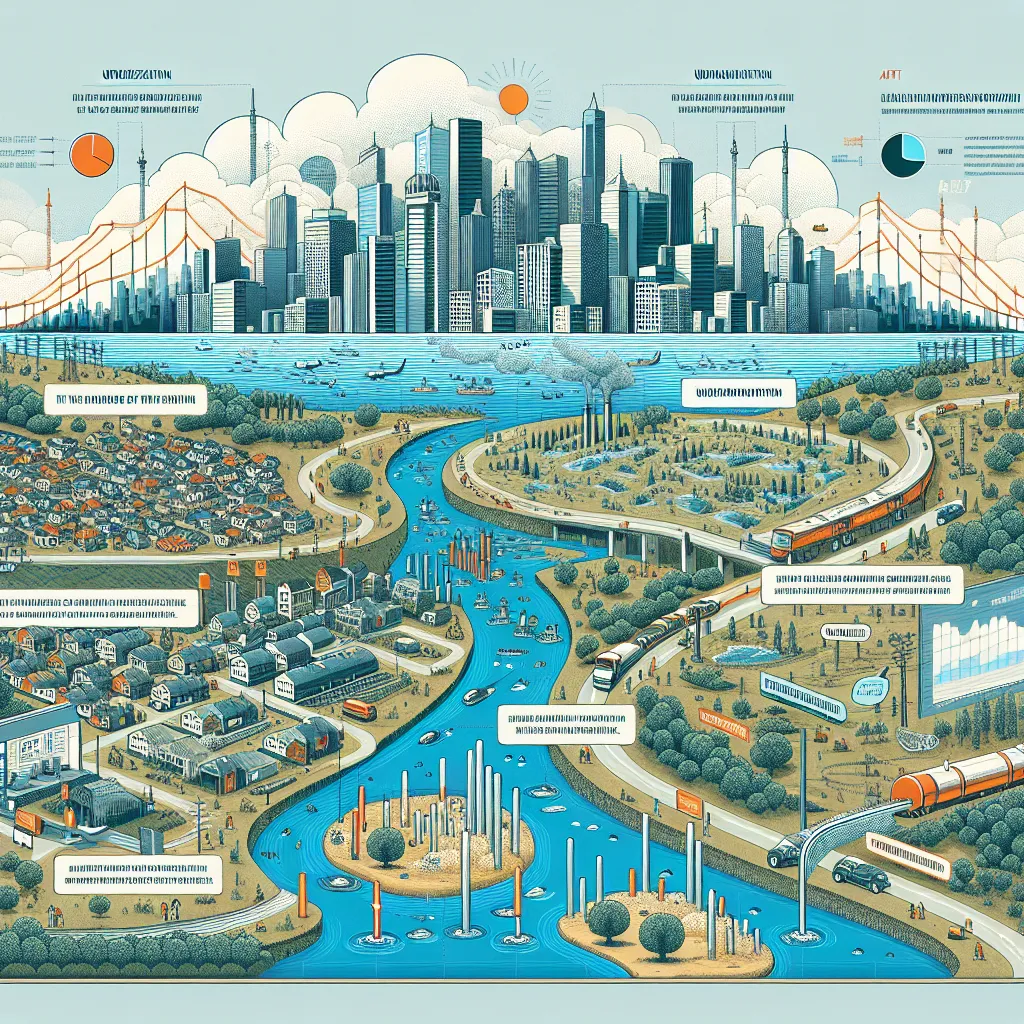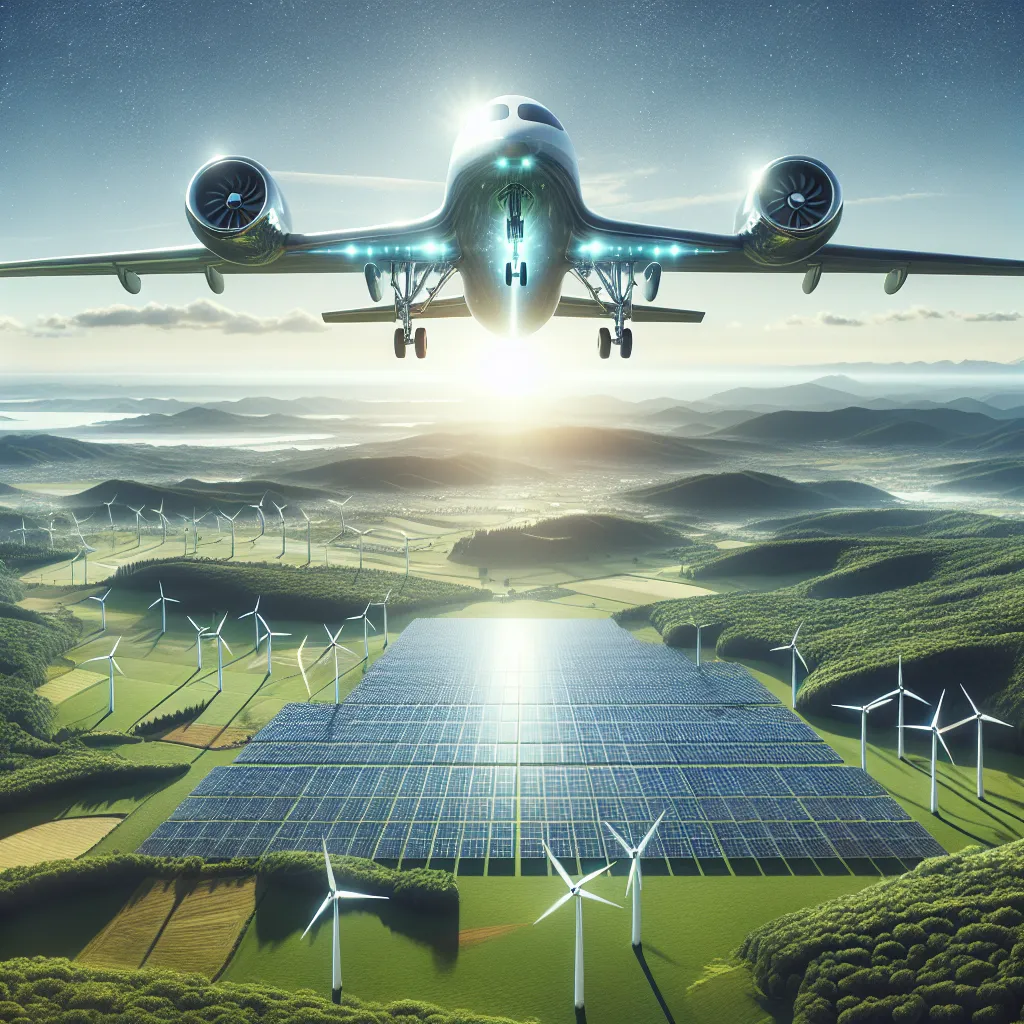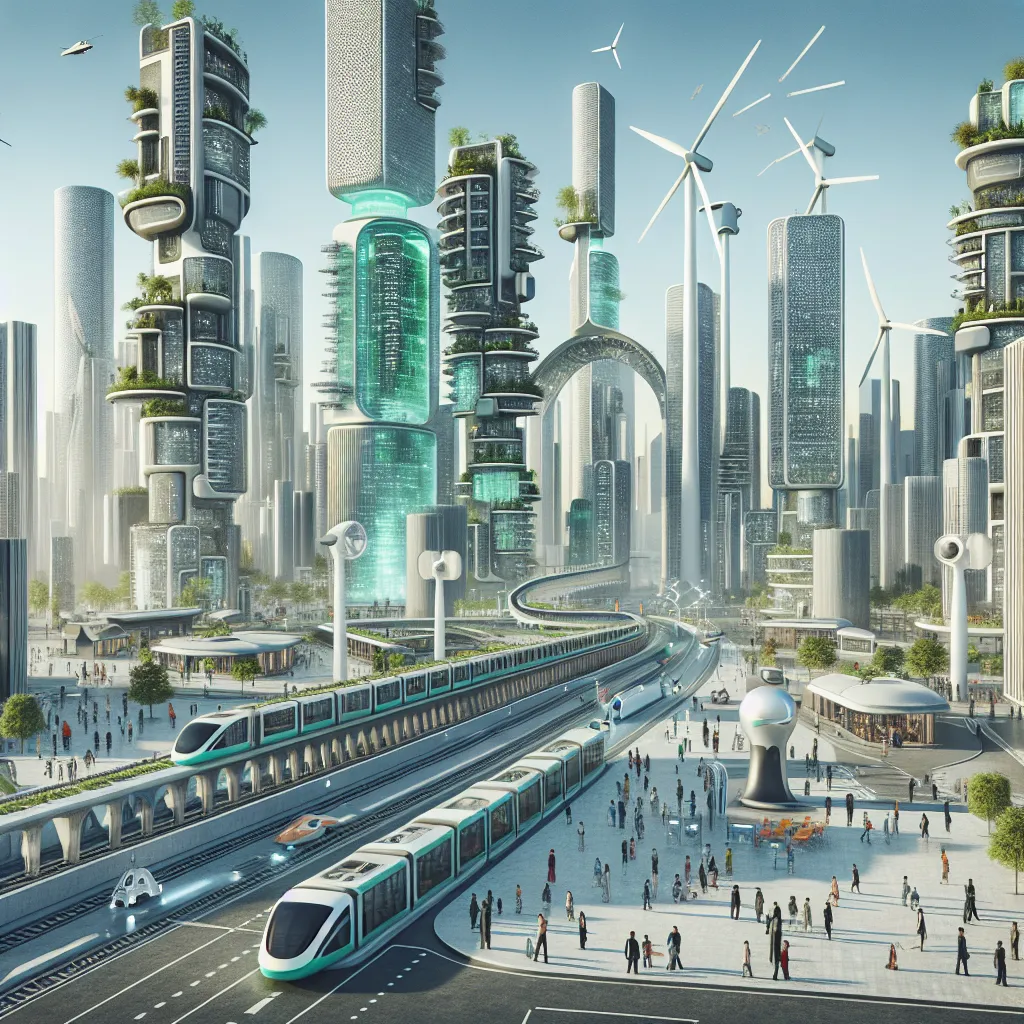Welcome to our IELTS Reading practice test focused on the impact of urbanization on water resources. This comprehensive test will help you prepare for the IELTS Reading section by providing a realistic exam experience with passages of increasing difficulty and a variety of question types.
Table Of Contents
- Introduction
- IELTS Reading Test
- Passage 1 – Easy Text
- Urban Water Challenges
- Questions 1-5
- Questions 6-10
- Passage 2 – Medium Text
- The Nexus of Urbanization and Water Scarcity
- Questions 11-14
- Questions 15-20
- Passage 3 – Hard Text
- Urbanization and Water Resources: A Global Paradigm Shift
- Questions 21-26
- Questions 27-30
- Answer Key
- Passage 1
- Passage 2
- Passage 3
 Urban water management
Urban water management
Introduction
The impact of urbanization on water resources is a critical global issue that affects millions of people worldwide. As cities expand and populations grow, the demand for water increases, putting tremendous pressure on existing water resources. This practice test will explore various aspects of this topic, challenging your reading comprehension skills and preparing you for the IELTS exam.
IELTS Reading Test
Passage 1 – Easy Text
Urban Water Challenges
Urbanization has become a defining feature of the 21st century, with more than half of the world’s population now living in cities. This rapid urban growth has profound implications for water resources management. As cities expand, they alter the natural water cycle, creating new challenges for water supply, wastewater management, and stormwater runoff.
One of the primary impacts of urbanization on water resources is the increased demand for clean water. As populations concentrate in urban areas, the need for potable water for drinking, sanitation, and industrial use grows exponentially. This often leads to the overexploitation of nearby water sources, such as rivers, lakes, and groundwater aquifers.
Moreover, urbanization typically results in the creation of large impervious surfaces like roads, parking lots, and buildings. These surfaces prevent rainwater from naturally infiltrating into the ground, instead channeling it quickly into storm drains and nearby water bodies. This altered hydrology can lead to increased flooding during heavy rainfall events and reduced groundwater recharge.
Water pollution is another significant concern in urban areas. As cities grow, they generate more wastewater and pollution from various sources, including households, industries, and transportation. Without proper treatment, this pollution can contaminate water bodies, threatening both human health and aquatic ecosystems.
Urban heat islands, a phenomenon where cities experience higher temperatures than surrounding rural areas, can also impact water resources. These elevated temperatures can increase evaporation rates from water bodies and soil, potentially exacerbating water scarcity issues in already stressed regions.
Despite these challenges, many cities are implementing innovative solutions to address urban water issues. These include water conservation programs, green infrastructure projects to manage stormwater, and advanced wastewater treatment technologies. By adopting integrated urban water management approaches, cities can work towards more sustainable and resilient water systems in the face of ongoing urbanization.
Questions 1-5
Do the following statements agree with the information given in the reading passage?
Write
TRUE if the statement agrees with the information
FALSE if the statement contradicts the information
NOT GIVEN if there is no information on this
- More than 50% of the world’s population lives in urban areas.
- Urbanization always leads to a decrease in water quality.
- Impervious surfaces in cities can contribute to increased flooding.
- Urban heat islands can lead to higher evaporation rates of water.
- All cities have successfully implemented water conservation programs.
Questions 6-10
Complete the sentences below.
Choose NO MORE THAN TWO WORDS from the passage for each answer.
- The increased demand for clean water in cities often results in the __ of nearby water sources.
- Large impervious surfaces in urban areas prevent rainwater from naturally __ into the ground.
- Without proper treatment, urban wastewater can __ water bodies.
- The __ phenomenon causes cities to experience higher temperatures than surrounding rural areas.
- Many cities are implementing __ infrastructure projects to manage stormwater.
Passage 2 – Medium Text
The Nexus of Urbanization and Water Scarcity
The rapid pace of urbanization across the globe has brought about unprecedented challenges in water resource management. As cities burgeon and expand, they invariably alter the hydrological cycle, often leading to a complex web of issues that threaten water security. This intricate relationship between urban growth and water resources demands a nuanced understanding and innovative solutions.
One of the most pressing concerns is the strain on water supply systems. Urban areas, with their dense populations and industrial activities, require vast quantities of water. This demand often outstrips the capacity of local water sources, forcing cities to seek water from increasingly distant locations. For instance, Mexico City, built on a former lakebed, now sources much of its water from hundreds of kilometers away, pumping it over mountain ranges at significant economic and environmental costs.
The impermeability of urban landscapes further exacerbates water-related challenges. As natural surfaces are replaced with concrete and asphalt, rainwater that would typically replenish groundwater aquifers instead becomes runoff. This not only reduces natural water storage but also increases the risk of urban flooding. Cities like Singapore have addressed this issue by implementing extensive rainwater harvesting systems, transforming urban areas into water catchments.
Water pollution in urban areas presents another critical challenge. Industrial effluents, domestic sewage, and non-point source pollution from urban runoff contaminate water bodies, rendering them unsuitable for use without extensive treatment. In many developing countries, inadequate wastewater treatment infrastructure means that a significant proportion of urban wastewater is discharged untreated into the environment, posing severe health risks and degrading ecosystems.
Climate change adds another layer of complexity to urban water management. Many cities face increased variability in rainfall patterns, with some experiencing more frequent and intense droughts, while others grapple with heavier precipitation events. This variability challenges traditional water management approaches and necessitates more adaptive and resilient strategies.
However, the challenges posed by urbanization also present opportunities for innovation in water management. Water-sensitive urban design is gaining traction, incorporating principles of water conservation, reuse, and natural water cycle mimicry into urban planning. Cities like Philadelphia have implemented green infrastructure solutions, such as rain gardens and permeable pavements, to manage stormwater more sustainably.
Moreover, technological advancements are enabling more efficient water use and management. Smart water metering systems allow for real-time monitoring of water consumption, helping to identify leaks and reduce waste. Advanced wastewater treatment technologies are making water recycling and reuse increasingly viable, turning what was once considered waste into a valuable resource.
The future of urban water management lies in integrated approaches that consider the entire urban water cycle. This includes not only water supply and wastewater management but also stormwater management, ecosystem protection, and climate resilience. By adopting such holistic strategies, cities can work towards ensuring water security in an increasingly urbanized world.
Questions 11-14
Choose the correct letter, A, B, C, or D.
-
According to the passage, Mexico City’s water supply situation is characterized by:
A) Abundant local water sources
B) Efficient water conservation methods
C) Transporting water over long distances
D) Sustainable groundwater extraction -
The impermeability of urban surfaces leads to:
A) Increased groundwater recharge
B) Reduced risk of flooding
C) Better water quality in rivers
D) Higher amounts of surface runoff -
Which of the following is NOT mentioned as a challenge posed by climate change to urban water management?
A) More frequent droughts
B) Heavier precipitation events
C) Increased water pollution
D) Variable rainfall patterns -
The passage suggests that the future of urban water management should:
A) Focus solely on water supply
B) Ignore climate change impacts
C) Adopt an integrated approach
D) Prioritize economic growth over water conservation
Questions 15-20
Complete the summary below.
Choose NO MORE THAN TWO WORDS from the passage for each answer.
Urbanization significantly impacts the (15) __, creating various water-related challenges. The high demand for water in cities often exceeds the capacity of (16) __, leading to the need for long-distance water transportation. Urban surfaces’ (17) __ reduces natural water storage and increases flood risks. Water pollution from various sources, including (18) __, poses health risks and degrades ecosystems. Climate change further complicates water management, requiring more (19) __ strategies. However, innovations like water-sensitive urban design and (20) __ are helping cities address these challenges more effectively.
Passage 3 – Hard Text
Urbanization and Water Resources: A Global Paradigm Shift
The inexorable march of urbanization in the 21st century has precipitated a paradigm shift in the management of water resources globally. This transformation is characterized by the complex interplay between burgeoning urban populations, finite water resources, and the imperative for sustainable development. The ramifications of this shift are multifaceted, encompassing not only the physical alterations to hydrological systems but also the socio-economic and political dimensions of water governance in an increasingly urbanized world.
At the crux of this paradigm shift is the recognition that traditional, siloed approaches to urban water management are no longer tenable. The conventional segregation of water supply, wastewater treatment, and stormwater management as distinct entities fails to address the intricate interdependencies within urban water systems. This realization has given rise to the concept of Integrated Urban Water Management (IUWM), a holistic approach that considers the entire urban water cycle as a single, interconnected system.
The implementation of IUWM necessitates a fundamental recalibration of urban planning and design principles. Cities are increasingly being conceptualized as catchments, with the potential to harvest, treat, and reuse water within their boundaries. This shift is exemplified by initiatives such as the “sponge city” concept in China, which aims to enhance urban water absorption and retention through a combination of green and grey infrastructure. Similarly, the notion of water-sensitive urban design (WSUD) in Australia integrates water cycle management with urban planning and design, fostering cities that are resilient, livable, and sustainable.
The advent of smart technologies and big data analytics is revolutionizing urban water management. Advanced sensing technologies, coupled with artificial intelligence and machine learning algorithms, enable real-time monitoring and predictive modeling of urban water systems. This data-driven approach facilitates proactive management strategies, optimizing water distribution networks, predicting infrastructure failures, and enhancing the efficiency of wastewater treatment processes.
However, the technological solutions must be complemented by robust governance frameworks and innovative financing mechanisms. The fragmentation of institutional responsibilities for water management in many urban areas often leads to inefficiencies and conflicts. Overcoming these challenges requires collaborative governance models that foster coordination among various stakeholders, including government agencies, utilities, private sector entities, and communities.
Furthermore, the financial implications of upgrading and maintaining urban water infrastructure are substantial. Many cities, particularly in the developing world, face significant funding gaps for water-related investments. This necessitates exploring alternative financing models, such as public-private partnerships, green bonds, and value capture mechanisms, to mobilize the required capital for sustainable urban water systems.
The impact of urbanization on water resources extends beyond city boundaries, influencing regional and even global hydrological cycles. Urban water demand often leads to the appropriation of water resources from surrounding rural areas, potentially exacerbating rural-urban disparities and conflicts. This underscores the need for integrated regional planning approaches that balance urban water needs with those of rural and natural ecosystems.
Climate change adds another layer of complexity to urban water management. The increased frequency and intensity of extreme weather events, coupled with long-term shifts in precipitation patterns, challenge the resilience of urban water systems. Adaptive management strategies, incorporating scenario planning and flexible infrastructure designs, are crucial for enhancing urban water resilience in the face of climatic uncertainties.
In conclusion, the impact of urbanization on water resources represents a critical challenge of our time, necessitating a paradigm shift in how we conceptualize, plan, and manage urban water systems. This shift encompasses technological innovations, governance reforms, and a reimagining of the relationship between cities and their water resources. As urbanization continues apace, the successful navigation of this paradigm shift will be instrumental in ensuring water security, environmental sustainability, and the overall livability of our urban future.
Questions 21-26
Complete the summary below.
Choose NO MORE THAN TWO WORDS from the passage for each answer.
The impact of urbanization on water resources has led to a (21) __ in global water management. Traditional (22) __ to urban water management are no longer effective, leading to the development of Integrated Urban Water Management (IUWM). This approach views the entire urban water cycle as a(n) (23) __ system. Cities are now being conceptualized as (24) __, with the potential to harvest and reuse water. The implementation of IUWM requires a recalibration of urban planning principles and the use of smart technologies. However, these technological solutions must be supported by robust (25) __ and innovative financing mechanisms. The impact of urbanization on water resources extends beyond cities, influencing (26) __ hydrological cycles and necessitating integrated regional planning approaches.
Questions 27-30
Choose the correct letter, A, B, C, or D.
-
According to the passage, the concept of “sponge cities” in China aims to:
A) Increase water consumption in urban areas
B) Enhance urban water absorption and retention
C) Reduce the use of grey infrastructure
D) Promote water exportation to rural areas -
The passage suggests that the fragmentation of institutional responsibilities in urban water management often results in:
A) Improved water quality
B) More efficient use of resources
C) Inefficiencies and conflicts
D) Better coordination among stakeholders -
The author implies that the appropriation of water resources by cities from surrounding rural areas may:
A) Improve overall water management
B) Reduce urban water demand
C) Enhance rural development
D) Exacerbate rural-urban disparities -
In the context of climate change, the passage emphasizes the importance of:
A) Rigid infrastructure designs
B) Adaptive management strategies
C) Increased water consumption
D) Reduced urban development
Answer Key
Passage 1
- TRUE
- FALSE
- TRUE
- TRUE
- NOT GIVEN
- overexploitation
- infiltrating
- contaminate
- urban heat islands
- green
Passage 2
- C
- D
- C
- C
- hydrological cycle
- local water sources
- impermeability
- industrial effluents
- adaptive
- smart water metering
Passage 3
- paradigm shift
- siloed approaches
- interconnected
- catchments
- governance frameworks
- regional
- B
- C
- D
- B
By practicing with this IELTS Reading test on the impact of urbanization on water resources, you’ve engaged with a crucial global issue while honing your reading comprehension skills. Remember to analyze the passages carefully, paying attention to key details and overall themes. This approach will serve you well in the actual IELTS exam.
For more practice on related topics, you might find these articles helpful:
- Impact of Climate Change on Water Availability in Arid Regions
- How Urbanization is Affecting Green Space Availability
- Impact of Urbanization on Flood Management Systems
Keep practicing and stay informed about global issues like urbanization and water resources. This knowledge will not only help you in the IELTS Reading test but also contribute to your understanding of important contemporary challenges.


